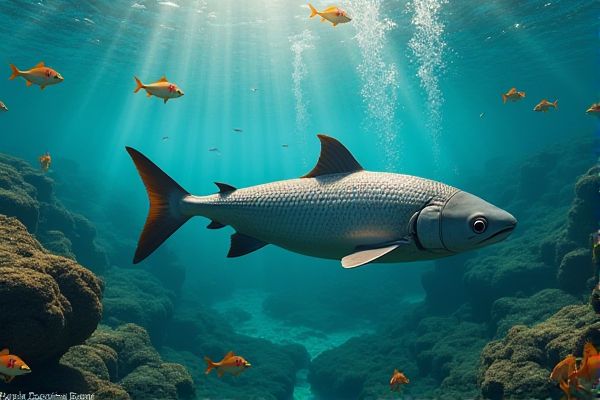
AI technology enhances aquaculture practices by improving fish monitoring and habitat management. Automated systems analyze water quality and feed efficiency in real time, ensuring optimal growth conditions. Machine learning algorithms predict fish health issues, allowing for timely interventions and reducing the risk of disease spread. Overall, integrating AI promotes sustainability and boosts productivity in aquaculture operations.
AI usage in aquaculture practices
Precision Feeding Systems
AI usage in aquaculture, particularly in Precision Feeding Systems, offers significant advantages. These systems analyze real-time data to optimize feed distribution based on the specific needs of fish, potentially enhancing growth rates and reducing waste. Institutions like the University of Stirling are researching these technologies to improve sustainability in fish farming. Implementing AI in aquaculture can lead to more efficient resource management and increased profitability for producers.
Water Quality Monitoring
AI can enhance water quality monitoring in aquaculture by predicting harmful conditions and optimizing resource use. For instance, the integration of machine learning algorithms can analyze parameters such as pH, oxygen levels, and temperature to ensure fish health. Companies like AquaManager utilize these technologies to provide real-time data, enabling efficient management decisions. This leads to the potential reduction of mortality rates and increased yield, benefiting stakeholders in the aquaculture industry.
Automated Disease Detection
AI usage in aquaculture can enhance disease management through automated systems capable of early detection. These systems analyze data from water quality sensors and fish behavior to identify potential health issues, improving fish welfare and reducing losses. Institutions like the World Aquaculture Society highlight the benefits of integrating AI for sustainable practices. By adopting such technology, aquaculture operations may increase efficiency and profitability while minimizing environmental impact.
Stock Management Optimization
AI has the potential to enhance stock management optimization in aquaculture by analyzing data related to fish growth and health. For example, institutions like the University of California, Davis are exploring machine learning algorithms to predict optimal feeding schedules. This technology can improve resource allocation and reduce waste, potentially increasing overall yield. Implementing AI solutions might also enable aquaculture operations to respond more swiftly to environmental changes, thus maximizing productivity.
Predictive Growth Analytics
AI can enhance aquaculture practices through predictive growth analytics, allowing farmers to optimize feeding schedules and resource allocation. By analyzing data from various environmental factors, such as water quality and temperature, AI can predict optimal growth conditions for species like tilapia. This capability can lead to increased yield and reduced waste, benefiting both producers and consumers in the seafood market. Implementing AI solutions may result in more sustainable practices within the aquaculture industry.
Environmental Impact Assessment
AI applications in aquaculture can enhance monitoring and efficiency in fish farming, leading to improved yields. Using machine learning algorithms, farmers can predict optimal feeding times and conditions, thereby reducing waste. Environmental Impact Assessments supported by AI can identify potential ecological risks, promoting sustainable practices. For example, institutions like the Food and Agriculture Organization (FAO) can leverage AI tools to gain insights into the health of aquatic ecosystems.
Biosecurity Monitoring
AI can enhance biosecurity monitoring in aquaculture by analyzing data from various sources to detect potential health risks. For instance, implementing machine learning algorithms can help identify patterns in fish disease outbreaks, allowing farmers to take proactive measures. Companies like AquaBioTech Group are increasingly using AI-driven solutions to optimize their biosecurity protocols. This technology may offer significant advantages in improving fish health and ensuring sustainable production practices.
Automated Farm Equipment
AI usage in aquaculture practices can enhance efficiency and productivity in fish farming. Automated farm equipment, such as feeding systems and water quality monitors, allows for precise management of resources. This technology can significantly reduce labor costs and minimize waste, presenting an opportunity for higher profitability. Implementing AI-driven solutions can also lead to better health management in fish populations, which is crucial for sustainable aquaculture.
Data-Driven Site Selection
AI implementation in aquaculture can enhance site selection by analyzing environmental factors, such as water quality and temperature, which influence fish health and growth. Tools that utilize machine learning algorithms can predict optimal locations for fish farming based on historical data patterns. For instance, institutions like the University of Florida are exploring data-driven methodologies to improve sustainability in aquaculture. Using AI may lead to more efficient resource allocation and better decision-making in site selection, ultimately benefiting the industry.
Integrated Ecosystem Analysis
AI can enhance aquaculture practices by optimizing feeding strategies and monitoring water quality. Integrated Ecosystem Analysis allows for a more comprehensive understanding of fish farming impact on local ecosystems. For example, using AI algorithms can predict fish growth rates, leading to better resource allocation. This technological integration could improve yield and sustainability, providing significant advantages for institutions like marine research centers.
 techknowy.com
techknowy.com